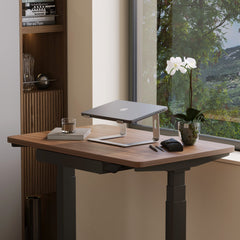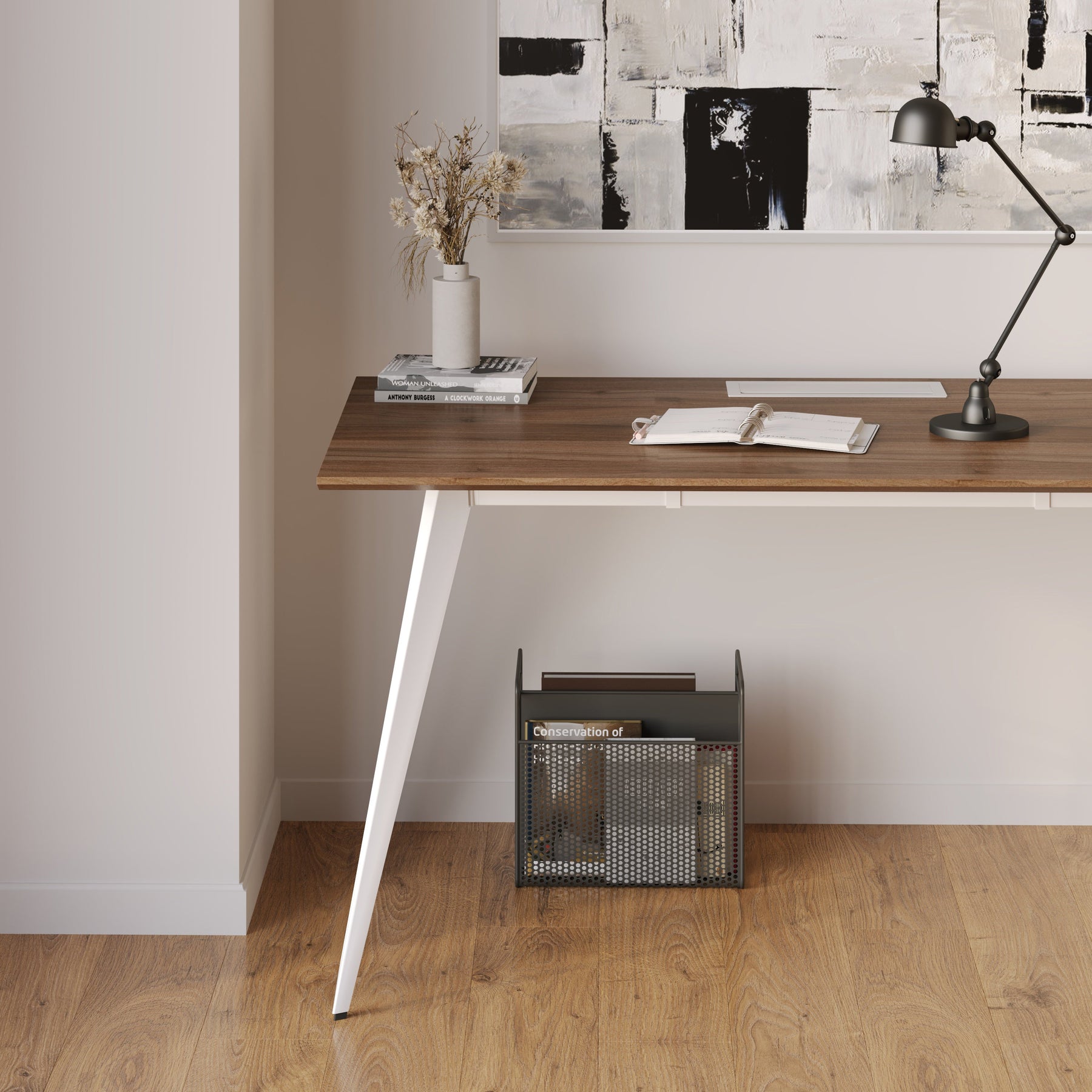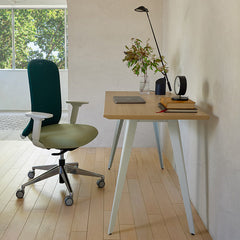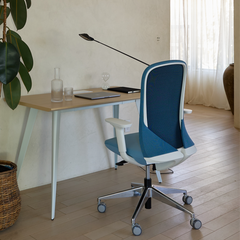Get 10% off your first order
Find the office furniture that’s designed to match your style, comfort, and needs perfectly. Subscribe
Hidden Hazards: 5 Ergonomic Traps Derailing Your Remote Work

Visit quiz page to see how we makes it easy to create an inspiring workplace


For many, the line between the office and the home has vanished. While working from a kitchen counter or a corner of the living room offers flexibility, it creates a persistent problem: how do you signal to your brain (and your family) that you are "at work" when your commute is only ten feet? Without clear physical and psychological boundaries, productivity suffers, and personal life bleeds into the workday, leading to burnout.
The challenge is not just spatial; it is behavioral. We need architectural and design cues to help us mentally switch gears. When your computer sits next to your TV, the temptation to mix modes is constant. By using intentional design, furniture placement, and simple rituals, you can create a dedicated mental "switch" that separates the intense focus of "Work Mode" from the restorative calm of "Home Mode," even in the smallest apartment.
Our brains rely heavily on environmental cues to dictate behavior. A dedicated workspace tells your mind: this is the zone for concentration and tasks. Conversely, leaving work items scattered throughout your home signals that work is never truly finished. The goal is to use physical design as a tool for behavioral conditioning.
The ability to physically transform your workspace is key to this separation. A height-adjustable standing desk allows you to change your physical relationship to your work, serving as a powerful, non-verbal signal that you are active and engaged, versus relaxing on a couch.
The most effective way to separate your work and home life in one room is to create a visual barrier. This physical definition helps both you and others respect the "office" zone. This does not require building walls; it requires intentional spatial planning.
If you cannot dedicate an entire room to work, use existing elements to break up the space. The visual wall should clearly mark the zone where focused effort is required.
Bookcases or Shelving: Place a tall, open-backed bookshelf perpendicular to the wall to create a soft divider between the work area and the living space.
Folding Screens: Use decorative partitions or screens that can be put away when not in use.
Strategic Desk Placement: Position your modern office desk so your back is to the home area, keeping distractions out of your immediate field of vision.
Area Rugs: Use a different colored or textured rug under your desk area to visually define the office "footprint."
This separation ensures that when you look up from your screen, you see a barrier, not the television or the laundry basket, preserving your mental state.
One of the greatest contributors to boundary blur is visual creep: the slow spread of work tools into living areas. The "put-away" ritual is the physical act that signals the end of the workday, helping your brain transition immediately to "Home Mode."
If your workspace is a corner of a living area, the rule must be strict: when the workday is over, the work must disappear. This involves making sure the desk itself offers quick and efficient storage solutions.
Workday Closeout Checklist:
☐ Tuck Cables: Unplug and coil charging cables, storing them in a small drawer.
☐ Clear the Surface: All papers, notepads, and pens are placed inside drawers or covered boxes.
☐ Close the Laptop: Shut down the computer and put it out of sight, if possible.
☐ Change the Light: Turn off the task lamp and turn on the softer, ambient home lighting.
Beyond visual barriers, you can use sensory input—light and sound—to cue your brain into different modes. These are subtle but powerful tools for behavioral conditioning.
Your brain can be trained to associate specific sensory inputs with specific behaviors. By making a clear change to your environment, you signal the shift from concentration to relaxation.
Sensory Cues for Mode Switching (Enumeration):
Work Lamp On, Home Lights Off: Use a bright, directional task lamp (for focus) and keep ambient room lights dim or off during the workday.
Dedicated Work Audio: Use a specific type of background sound (e.g., instrumental music or brown noise) only for work. When you stop the music, your brain registers the shift.
Aromatherapy: Use a stimulating scent (like peppermint or citrus) in the work zone only, switching to a relaxing scent (like lavender) once the workday ends.
In small living situations, space-saving design is not just convenient; it is essential for maintaining clear boundaries. Furniture designed for compact, flexible living actively supports the separation of modes by offering maximum function in minimum space.
For those working in extremely compact areas, choosing furniture that fits precisely into an unused niche is the foundation of separation. For a seamless fit into a challenging apartment footprint, a narrow Small Standing Desk Rhode Island can provide the full ergonomic benefits of height-adjustability without invading the rest of the room. This preserves floor space, making the "Home Mode" feel less crowded by the office.
Look for items that visually disappear or change function.
Fold-down desks attached to a wall.
Compact, stackable or foldable chairs that can be stored in a closet.
Desks with minimal depth that fit behind a door or in a hallway nook.

In a traditional office setting, the drive or walk home serves as a vital psychological buffer—the "digital commute." Remote workers must replicate this boundary-setting process artificially, using time and ritual to mentally shift out of "Work Mode."
The "digital commute" is a mandatory period of disconnection between your last work task and your first home task.
The Transition Ritual (Table):
|
Time of Day |
Action |
Purpose |
|
5:00 PM |
Formal shutdown (emails closed, desktop cleared). |
Signals the absolute end of work tasks. |
|
5:05 PM |
Desk Put-Away Ritual. |
Physically removes the visual presence of work. |
|
5:15 PM |
15-Minute "Commute" Walk/Activity. |
Replicates the psychological buffer of travel. |
|
5:30 PM |
Personal Activity (Cooking/Reading). |
Firmly switches the brain into "Home Mode." |
Many remote workers confuse "comfort" with "ergonomics." Your work chair should be firm and supportive to encourage alertness and neutral posture, while your home seating should be soft and relaxing. This distinction helps reinforce the mode switch.
Using two different standards of comfort—one for active work and one for passive relaxation—helps your body signal to your mind which mode to enter. An adjustable ergonomic chair encourages constant, supportive movement required for concentration. The couch encourages relaxation and stillness.
Even when working alone, remote workers may share their space with a partner or housemate who also works from home. The boundary-setting challenges double when the workspace is a shared resource.
Shared spaces require highly functional and adjustable furniture that grants each individual control over their immediate environment. A two-person standing desk offers independent height controls and defined surface areas, ensuring that the working proximity does not lead to ergonomic conflicts or clutter overflow, thereby preserving boundaries.
Agree on non-verbal signals for "do not disturb."
Establish quiet hours and meeting schedules.
Assign specific storage areas to prevent mixing up materials.
Visual noise is any element that draws your eye unnecessarily. In a combined work-home space, the greatest source of visual noise is often the clutter of daily life (e.g., kitchen gadgets, remotes, clothing).
To keep your "Work Mode" focused, you must actively declutter the visible "Home Mode" area. The eye will travel to the mess, even if it is not on your desk.
Visual Noise Reduction (Checklist):
☐ Storage: Use closed storage (cabinets, containers) for living area clutter.
☐ Aesthetics: Keep the visual style simple and cohesive to minimize sensory agitation.
☐ Sightlines: Position your desk so your back is to the highest-traffic or most visually busy area of the room.
☐ Minimalism: Remove items that serve no decorative or essential function from the room.
The effort of setting and maintaining these boundaries is repaid through reduced stress, better sleep quality, and decreased likelihood of burnout. The ability to mentally disconnect is vital for psychological restoration.
Having clear work boundaries gives the worker a sense of control over their job and their personal life. The psychological benefits of feeling this control, especially when working remotely, are immense.
A study on work engagement and well-being confirms that having sufficient job resources—which includes a supportive and controllable physical workspace—is directly linked to higher engagement and significantly lower levels of burnout. The physical separation enables the mental separation required for well-being.

Small, highly adjustable accessories can make a huge difference in separating the space. These tools allow you to temporarily customize your environment for work and then easily restore it to home use.
Adjustable Monitor Supports: Using hardware that allows you to easily reposition your screen is key. A precision ergonomic monitor arm lets you pull your screen forward for focused work and push it completely out of the way against the wall when in "Home Mode."
Headphones: Dedicated noise-canceling headphones are an auditory boundary that instantly puts you in "Work Mode."
Portable Storage: Small, handled caddies or totes for papers and stationery allow for fast, complete removal from the surface.
The true victory in a combined space is making the office disappear completely when it is time to relax. The goal of the hardware is not to be permanent, but to be easily movable, supporting the seamless transition between the two modes.
Separating "Work Mode" and "Home Mode" in a single space is the ultimate remote work design challenge. It is not about size; it is about intentionality. By defining your space using visual boundaries, implementing strong sensory cues, and committing to clear temporal rituals, you build a personal switch for your brain. This switch allows you to engage deeply during the day and fully disengage at night. Invest in the architecture of your focus, and you will find both your professional and personal lives will thrive, even when they occupy the very same room.

Hidden Hazards: 5 Ergonomic Traps Derailing Your Remote Work

Decoding Deep Work: The Neuroscience of Your Desktop

How to Stay Focused and Motivated While Working from Home
Get 10% off your first order
Find the office furniture that’s designed to match your style, comfort, and needs perfectly. Subscribe
Leave a comment